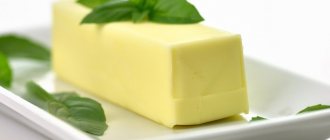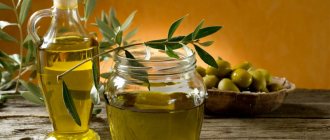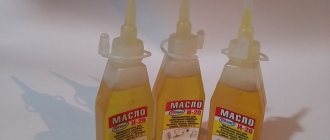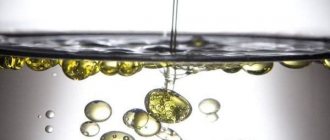Butter is used for cooking, used in sandwiches and used in baking. Any product is stored for a certain period of time and oil is no exception; if the conditions are not met, it will quickly deteriorate and lose its taste. In our article we will tell you how to properly store the product, determine the shelf life of butter according to GOST, and talk about the conditions.
Product preservation conditions
Shelf life is specified in GOST 32261-2013 , and they depend primarily on temperature, type of packaging and type of product.
Butter comes in sweet cream and sour cream varieties, each type is divided into salted and unsalted subtypes. We will not delve into the intricacies of production, we will only note that the basis for the production of the sweet variety is pure cream, and the main condition for sour cream products is the presence of lactic acid bacteria.
The following conditions affect safety:
- The temperature should vary from -180C to +50C.
- Required humidity: 70-90%.
- The packaging must be sealed.
- The amount of light is minimal.
Based on the temperature information provided, it becomes clear that storing butter in the refrigerator is the best option. If we consider options without a refrigerator, then this can be done on the balcony or on the street, but only in the cold season.
Basements and cellars are not entirely suitable places; oil can be stored here, but not for long, including due to high humidity.
Storage without refrigeration
It is possible to store the product without refrigeration for a long time. To do this, you need to prepare it correctly.
The first method will require enamel or glass containers, parchment, and salt.
- The product is divided into parts and wrapped in parchment paper.
- The briquettes are placed in a pan, into which a brine solution is then poured (25 g of salt per 1 liter of drinking water).
- Portions of oil are pressed down, for example, using a massive plate, so that they do not float to the surface.
- Cover the pan with a lid and put it in a cool, dark place.
You can also place the oil, divided into parts, into a clean cloth previously soaked in table vinegar. Place in a cool, dark place. It is important that there is no exposure to sunlight.
Learn how to properly melt butter for storage and how to store it later.
The methods will preserve the freshness and taste of the product for several weeks at a relative humidity of no more than 90%. Without special preparation, butter can be stored at room temperature without exposure to ultraviolet rays for one week.
Sunlight accelerates the deterioration of the product: the nutritional value decreases, yellowing occurs, the oil turns sour
If suddenly the product is exposed to direct sunlight and turns yellow, the situation can be saved. You need to do the following:
- Remove the top yellowed layer.
- Place the rest on a heated frying pan. Wait until the butter is completely melted.
- Remove the top substance and dispose of the sediment.
Do you know that…
Butter contains about 20 essential fatty acids, vitamins A, D, E, K. Under the influence of high temperatures and UV rays, substances oxidize and their beneficial qualities disappear.
How can you tell if the oil has gone bad?
It is worth focusing on the shelf life of butter if the storage conditions are observed. There are no guarantees that they were not violated during transportation, in a warehouse, on store shelves, or in a market.
How to identify a spoiled product:
- Inspect the packaging . Set aside packages with damaged foil and parchment. In places where there were ruptures, the piece was in contact with air. Microbes are concentrated there and spoilage processes are started.
- Inspect the piece . Uneven pigmentation, dark plaque, gray spots, changes in structure and consistency are a bad sign.
- Smell . Spoiled butter has a sour, musty odor. You can smell mold in the distance. Try it. A sour taste with hints of bitterness signals spoilage and expiration.
If, despite the normal taste, the oil still raises doubts, there is no need to use it fresh for sandwiches or cream. Like cottage cheese or milk, cheese, you can use it to make baked goods, casseroles, and other heat-treated foods.
Signs of a spoiled product
Determining whether a product is suitable for human consumption is quite simple. If it has any of the following characteristics, especially if stored outside the refrigerator, you should not eat it:
- bitter taste or notes of cloying;
- a pungent odor reminiscent of rotting or souring;
- loss of bar shape;
- appearance of wet drops on the surface;
- increase in product weight;
- presence of mold.
Natural butter, homemade or purchased in a store, has a short shelf life. A small bar can be stored in the refrigerator; larger pieces are better placed in the freezer, having previously been divided into smaller ones. Even in the absence of cooling household appliances, you can maintain the properties of the oil by using salt or vinegar.
Shelf life of butter
Butter belongs to the category of perishable products, so its shelf life is short.
First of all, the shelf life depends on the packaging and compliance with the temperature regime.
Packaged butter has a shelf life of 10 days if its wrapper is made of parchment, 20 days if the wrapper is made of foil.
The shelf life of homemade oil, made independently, has the same terms as that of the factory one, and depends on the packaging and storage conditions.
Butter with any fillers has a shelf life of 15 days. Ghee, which is fat rendered from butter, has the longest shelf life - up to 1 year.
Storage conditions and temperature
Creamy fat products are classified as perishable; storage requires compliance with certain conditions.
Primary requirements:
- temperature range from -18 to +5 °C;
- humidity from 70 to 90%;
- sealed packaging;
- lack of light.
Suitable storage locations:
- fridge;
- freezer;
- balcony, street in winter.
Unsuitable places:
- kitchen table, cabinet;
- street, balcony, veranda in the warm season;
- basement, cellar, damp rooms.
The shelf life of butter at a temperature of 0 +5°C is up to 2-5 weeks. Freshness is affected by weight and container. In the freezer for 75 days at a temperature of -3 to -14 °C. The maximum shelf life at -14 °C is 4 months. Recommended packaging: sealed containers, foil, vacuum bags.
Where do you prefer to store your butter?
In the refrigeratorIn the freezer
How long does butter last before and after opening the package?
For almost all types of oil, temperature is of great importance for shelf life.
In a refrigerator
For butter, it doesn’t really matter whether the packaging is opened or not, the main thing is the material from which it is made. If the packaging is paper (parchment), then this oil is stored in the refrigerator for about 10 days.
In order to extend its shelf life, you can transfer the oil to an oil dish with an opaque lid. Then the shelf life will increase to 15 days.
Oil packed in foil can be stored in its original packaging even after opening.
In the freezer
Can it be frozen? In the freezer at temperatures down to -15 ° C, oxidative processes in fat and oil products slow down sharply, but do not stop.
You can extend the shelf life of butter by putting it in the freezer. In this case, the oil can be stored for up to 1 year.
At room temperature
At room temperature, butter can be stored for a short time in the absence of heat sources or direct sunlight. Usually after 48 hours the oil begins to deteriorate.
Placing the oil under pressure helps to extend its shelf life at room temperature. Fill the oil with salted water, close the lid and place a weight on top. Using this old-fashioned method, the shelf life can be extended to 1 week.
Dependence on fat content
Let's consider shelf life depending on fat content, analyze regular butter of different fat content, as well as ghee and butter paste. We analyze products that are stored in unsealed polymer containers at temperatures from -30C to -60C. The data is presented in the table:
| Type, fat content | Timing, days |
| Oil paste with fat content up to 40% | 30 |
| Oil 40–49% | 50 |
| 50―59% | 50 |
| 60―69% | 60 |
| 72,5―79% | 60 |
| 80―85% | 60 |
| Ghee | 60 |
The table shows that the higher the fat content, the longer the sales and storage time.
Container and packaging
An oil dish is a bowl with a screw-on lid for storing the product of the same name. Only he will not lie in it for more than 10 days. The oil is often removed, oxygen, microbes from a knife, spoon, or some crumbs get into it. All this accelerates spoilage, increases acidity, and produces an unpleasant odor. We recommend putting a small amount in the oiler for use in the coming days. Store the rest of the mixture in another container.
Dishes and packaging options:
- parchment _ Used by manufacturers for factory packaging. Can be used at home. A parchment sheet allows odors to pass through. Oil cannot be stored for more than 3 weeks at above-zero temperatures and 60 days frozen;
- foil _ Better than parchment. Modern oil and fat factories have switched to foil wrapping. Extends shelf life twice as much as parchment;
- sealed polymer boxes, containers . Ideal container for freezing. At temperatures below -10°, the oil will not lose its properties and taste for four months;
- plastic containers with lids . Used for freezing and storing in the refrigerator. It is important to select the size to reduce the air gap.
Plastic bags are not the best packaging for storing butter at above-zero temperatures. But suitable for freezing. It is advisable to use food-grade polyethylene film. The best choice is vacuum bags. They increase shelf life.
Note to the hostess
- Butter should not be left on the table. So it spoils quickly.
- Oil becomes rancid if exposed to light for a long time. Therefore, the oil dish should not allow light to pass through.
- If the package of butter says “butter”, then it is real butter. In all other cases it is margarine. Or, as it is fashionable to call it now, “spread”.
- The color of butter is sometimes unreal, as it is often tinted with carotene.
- If the butter begins to deteriorate, then you need to mercilessly cut it off on all sides and melt it.
- Butter is not recommended for frying, as it then forms carcinogenic substances.
These simple tips will help any housewife keep butter fresh and tasty.
Fresh butter contains 82-84% fat and no more than 16% water, has a uniform yellowish color, and when pressed with a finger, releases droplets of water and does not crumble. If the oil releases whey, it means that it was not washed well after shaking and will quickly deteriorate.
Butter is stored in the refrigerator - this is common knowledge. The storage temperature should not exceed +6 degrees.
How to store vegetable oils (olive, flaxseed, sunflower)
When it comes to storing oils, there are three things to consider: where
store it,
how
to store it and
in what
.
Temperature
Before opening: let's start with the good news - most vegetable oils can be stored at room temperature, that is, at +20-24°C, but no more. The minimum permissible temperature is 5°C. Well, the optimal temperature is about 14°C. Only a wine refrigerator can provide such an ideal climate at home.
After opening: here’s the not-so-good news - unfortunately, most vegetable oils (olive, sunflower, flaxseed) must be consumed within 1 month after opening the bottle. After a month, the oil remains suitable for consumption, but it is still undesirable to use it in food, since toxic and even carcinogenic substances are formed in the product. A month after opening the package, the taste of the oil becomes bitter (especially for olive and linseed oil), and the aroma becomes neutral.
- A month after opening, olive oil can be used like sunflower oil for frying.
- After opening, it is advisable to store flaxseed oil in the refrigerator on the middle/top shelf or in the fruit and vegetable compartment.
Flaxseed oil is stored in the refrigerator after opening.
- Due to rapid rancidity, it is not very wise to buy large jars of olive, flaxseed and unrefined sunflower oil. It is better to buy the product less, but more often.
Where to store
So, all oils like dark, dry and cool (but not cold!) places. Where can you find them in the kitchen of a city apartment?
The optimal solution for both long-term and daily storage of oils is a closed cabinet, preferably a lower one (after all, the lower it is, the cooler it is) and not too close to the stove. It is not recommended to store spices and herbs next to oil, as it tends to absorb odors.
Unfortunately, the most convenient place for storing oil - the countertop - is the most unfavorable due to its proximity to the stove, daylight and artificial light, and temperature changes. But it’s so convenient to always have a bottle on hand, so what should you do? A compromise is possible: simply pour the oil from a large bottle into a small one with a reserve of one or two weeks. The bottle should be made of dark glass and should be kept away from the stove.
The ideal place for long-term storage of oils is a wine cellar or its modern substitute - a wine refrigerator with a temperature of 14 degrees. Can butter be stored in a regular refrigerator? Yes, you can, but be careful.
- Firstly, oil removed from the refrigerator cannot be left warm for a long time; it must be stored in a cupboard, then again in the refrigerator. Remember, sudden climate change is one of the enemies of any oil.
- Secondly, it is advisable to store butter in the refrigerator in the fruit and vegetable compartment (the temperature is set there at about 8 degrees) or on the top shelf (7 degrees). Do not forget that too low temperatures (below 5 degrees), which are typical for the middle and lower shelves of the refrigerator, are harmful to oils. But the refrigerator door is not the best option, since the climate on the door shelves, although optimal for storing oils, is too unstable.
By the way, there is one more nuance that only applies to olive oil: when stored in the refrigerator, white flakes form in it. There is no need to be afraid of this; on the contrary, such sediment only proves that the purchased oil is indeed olive oil. At room temperature it will regain its normal consistency.
How to store oil
The ideal glassware is dark glass (such as amber or cobalt) with a tight lid and possibly a dispenser or sprayer.
A ceramic vessel that can close tightly is also a good idea.
But metal containers (for example, those in which oil is often sold) are less suitable. As a rule, oil of average quality is sold in such packages.
The worst choice of containers for storing oil is plastic bottles. If you bought fresh and valuable oil (olive, flaxseed, unrefined or raw sunflower) in such packaging, say, at the market, then it should be poured into a dark glass bottle. In general, it is better to avoid buying oil in plastic packaging, since during storage, chemical compounds from the plastic that are harmful to health may transfer into the product. The only oils that can be sold in plastic packaging are refined sunflower and coconut oils.
- If you bought the oil in a transparent glass bottle, you can wrap it in foil.
See also: How to properly store vegetables and herbs
Resuscitation of spoiled oil
It is better to throw away rancid oil. However, there are situations when it becomes necessary to revive the product. There are several ways to help give spoiled oil a second life:
- If the outer surface turns yellow during storage, the discolored layer should be removed. This advice can be used when a change in color is the only sign of damage. After cutting off the top layer, you need to change the storage conditions for the remaining part.
- Spoiled butter can be melted. Subsequently, the product is used for cooking.
- The simplest way is to rinse with plain water. Afterwards, you need to salt the product and mix it with a small amount of carrot juice.
- A soda solution will help revive spoiled butter. The product is first treated with a liquid prepared from a teaspoon of soda dissolved in a glass of water, then washed and a pinch of salt is added.
- Stale butter can be mashed in milk. Then the product must be washed under running water.
See also
How and how long you can store cauliflower at home, rules and choice of location
Types of oil: division by fat content
A high-quality product obtained by churning cream has a fat content of at least 72.5%. All natural products contain milk fat. It has numerous beneficial properties.
Based on milk fat content, butter is divided into the following types:
- traditional – 82.5%;
- amateur – 80%;
- peasant - 72.5%;
- sandwich – 61%;
- tea – 50%.
The last two types of oil are not natural. They contain flavorings, emulsifiers, food additives, preservatives and other ingredients. The remaining varieties contain salt or are produced without it. You can find out about the content of specific components by carefully studying the product label.
How to choose
All-natural, high-quality butter has a short shelf life, unlike various types of counterfeit butter. Counterfeits consist of vegetable oils and various chemical additives, and can be stored for more than 3 months.
- The short shelf life of butter indicates the naturalness of the product. And the longer the period indicated on the packaging, the more preservatives and vegetable fats such a product contains.
- Products designated by GOST 32261 - 2013 have high consumer quality, meet all requirements and are absolutely natural. They do not contain vegetable fats or various additives to increase shelf life.
- It happens that the word GOST is written on the package, but there are no numbers next to it. Some manufacturers do this as a publicity stunt. Therefore, before purchasing such a product, it is necessary to carefully study the composition in order to understand whether it actually complies with GOST or not. Natural butter contains cream, milk, buttermilk, yeast and salt. Other additives of chemical origin and vegetable fats in the product indicate that this is most likely a spread.
- The fat content of quality products cannot be less than 72.5%, but not more than 82.5%. Ghee contains the largest amount of fat.
Characteristics of natural butter that complies with GOST 52253 - 2004 and GOST 32261 - 2013:
- pleasant creamy taste without any foreign aftertaste;
- uniform yellowish color;
- melts quickly when heated;
- in solid form it should not crumble when cut;
- releases moisture when pressed.
When purchasing, you should remember that this product cannot be of low cost. To prepare 1 kg. oils use about 20 liters of milk.
If the pack is deformed, the product may have already been defrosted, and it is not advisable to buy it.











